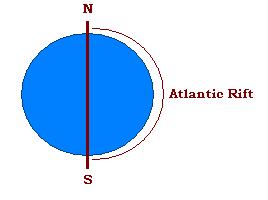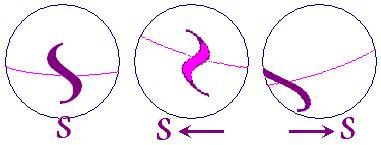
| |
 |
 The key to the Earth wobble many are now beginning to Notice, and the odd cold spot that lingers over
Hudson Bay and in the waters off Nova Scotia, lies in the shape of the Atlantic Rift. We have stated that
Planet X is skewed at least 45° along the Sun's magnetic flow lines, pointing its S. Pole away from the S. Pole
of the Sun as it rounds this pole, thus putting a tug on the Earth's N. Pole which is attracted and tempted to
align with Planet X in an end-to-end arrangement. The tilt of the Earth's N. Pole, leaning somewhat to the right
to the side of the Sun Planet X is rounding, has created a false season simulating Summer in the northern
hemisphere, were it not for the Constellations being out of place, an almost perfect mask for the approaching
monster about to upset life on Earth as its current inhabitants know it. For those with keen eyes and clear
eyes, for at least half the world from Japan to Ontario, an Earth wobble has become a reality.
The key to the Earth wobble many are now beginning to Notice, and the odd cold spot that lingers over
Hudson Bay and in the waters off Nova Scotia, lies in the shape of the Atlantic Rift. We have stated that
Planet X is skewed at least 45° along the Sun's magnetic flow lines, pointing its S. Pole away from the S. Pole
of the Sun as it rounds this pole, thus putting a tug on the Earth's N. Pole which is attracted and tempted to
align with Planet X in an end-to-end arrangement. The tilt of the Earth's N. Pole, leaning somewhat to the right
to the side of the Sun Planet X is rounding, has created a false season simulating Summer in the northern
hemisphere, were it not for the Constellations being out of place, an almost perfect mask for the approaching
monster about to upset life on Earth as its current inhabitants know it. For those with keen eyes and clear
eyes, for at least half the world from Japan to Ontario, an Earth wobble has become a reality.
The Atlantic Rift is skewed to the West in the northern hemisphere, and then to the East in the southern hemisphere, following the deepest cleft between the continents as they rip apart during what is commonly called the Continental Drift. As we have stated, this Atlantic Rift is itself a magnet as the tearing occurred during prior pole shifts and cooling magma was quickly aligned with the reforming poles, and thus becomes a third magnet encouraged to align with the Earth's core and Planet X during their encounters. At the point where the Atlantic Rift either faces or is in opposition to Planet X, this tugging to align occurs, creating the Global Quakes noted on live seismographs only during this past year, for the Earth, when Planet X has been in the vicinity. Why has an Earth wobble developed?

- We mentioned, in the Whiplash ZetaTalk, that ricochet effects and twirling are possible. Twirling? What does that mean? Why is the cold spot to the west of Hudson Bay the coldest spot on Earth? That’s not the N Pole. What point is pointing away from the Sun most of the day? Are we going to develop a wobble? Are we going to suddenly lurch about so that the Sun is rising and setting in a place way off from where the public would expect? This is in your future, folks, but we will not give you the date.
- ZetaTalk: Twirling Wobble, written May 25, 2004 on the Lou Gentile Show, live
- Tilting and leaning or aligning with the bully magnet that Planet X represents will occur, with ricochet effects and twirling possible to an extent we decline to reveal at this time.
- ZetaTalk: Whiplash, written April 14, 2004
Hudson Bay Cold Spot
Cold spot just west of the Hutson Bay noted in May.
And continuing, temps on Sunday June 20 in Alaska, 89°, in Michigan, 39°.